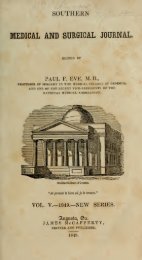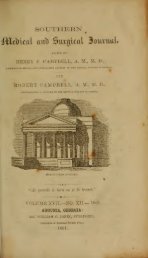788 Divisions for the Care of Deformities. [November,dons is formed is essentially similar in animals <strong>and</strong> in man;thatthe perfection of the reparative process is in direct proportionto the absence of extravasated blood <strong>and</strong> inflammatory exudation;<strong>and</strong> that the sheath of the tendons, when consisting ofbone-textured areolar tissue, as in the tendo-Achillis <strong>and</strong> othertendons surrounded by soft tissues, is of importance—1st. Inpreserving a connection between the divided extremities of thetendoQ. 2dly. In furnishing the matrix in which the nucleatedblastematous, or proper reparative material, is effused. 3dly.In giving definition <strong>and</strong> form to the newly -developed tendinoustissue. That the new tendon always remains as a permanenttissue, <strong>and</strong> as an integral portion of the tendon, the divided extremitiesof which it has been formed to reunite. In the specimenexhibited, in which Mr. Adams had divided the tendo-Achillis three years previous to death, an inch <strong>and</strong> a quarter ofnew tendon was clearly traceable. The average length of newtendon formed in children to reunite the divided extremities ofthe tendo-Achillis, Mr. Adams considers to be from half an inchto an inch, <strong>and</strong> in adults from one to two inches. The authorconsiders the facts adduced in this paper were amply sufficientto disprove the linear-cicatrix theory—the theory at present invogue, <strong>and</strong> supported by all his colleagues—which assumed thatthe newly-formed tendinous structure has a disposition to undergoa process of gradual contraction, such as we see taking placein the cicatrices of the skin after burns, to which it has beencompared, <strong>and</strong> that ultimately it becomes absorbed, the muscularstructure at the same time becoming elongated by the forceof the contraction of the cicatrix, so as to allow of the reapproximationof the ends of the divided tendons, <strong>and</strong> the formation ofa linear-cicatrix. From the present observations it appearedthat in the cure of deformities, muscles are elongated by the increasedlength of their tendons, obtained by means of subcutaneousdivision, <strong>and</strong> the development of new tendon formed forthe purpose of reuniting the divided extremities of the old tendon.The mechanical <strong>and</strong> physiological effects of this increasedlength of the tendons w r ere described; <strong>and</strong> lastly the authorstated that when recontraction of the foot takes place, <strong>and</strong> thedeformity returns at a distant period after tenotomy, this doesnot depend upon absorption of the new material, or new tendinoustissue formed previously to unite the divided extremitiesof the old tendon, but upon structural alterations taking placein the muscular tissue. In three cases of relapsed deformity ofthe foot examined by the author, the new tendinous tissueformed after the previous operations remained, <strong>and</strong> could beeasily distinguished from the old tendon. These facts were regardedas additional evidence against the linear-cicatrix theory.\_Med. Times <strong>and</strong> Gazette.
;1859.] Incision in Anthrax. 789Incision in Anthrax.Maurice H. Collins, Surgeon to Meath Hospital, says {DullinQuarterly Journ. Med. Sciences, August, 1859) that " the incisioninto anthrax, whether made early or delayed till sloughing hasdone part of the surgeon's work, must be deep rather than extensive.Usually it is said anthrax is a flat swelling. The factof its flatness, or rather of its extent, hides the real amount ofelevation, which is, in most cases, considerable. Hence incisionsinto anthrax seldom go down through the inflamed skin <strong>and</strong>areolar tissue. But even if they did go down to the fascia, theywould fail in effect unless they also went through it. The fasciais highly inflamed in anthrax ; in fact the essential differenceof anthrax from furuncle .consists in the inflammation beingdeeper <strong>and</strong> implicating the fascia. When fascia is inflamed, muchplastic exudation takes place, both in its substance <strong>and</strong> underit ; <strong>and</strong> the tendency of anthrax to spread indefinitely is to bethus accounted for. The pent-up plasma, quickly producingpus <strong>and</strong> slough, can get no vent until there is an adequate openingin the fascia, <strong>and</strong> this opening should be made by the surgeonas early as possible, if he would avoid the unpleasantnessof useless <strong>and</strong> repeated cutting, <strong>and</strong> the extensive sloughingwhich will occur if he neglect to make it. Plastic exudationsfind great facility in travelling under the fascia, dissecting <strong>and</strong>destroying its vascular connections, <strong>and</strong> ultimately causingmuch of it to perish. This is well known, as a general principleof surgery, <strong>and</strong> it is strange to find it overlooked as the cause ofthe spread of anthrax. We readily acknowledge the mischiefit does in periostitis, in diffused inflammations of erysipelatouscharacter or connected with paronychia, <strong>and</strong> in many otheranalogous cases ; but books of surgery are, for the most part,silent about it in the case of anthrax. And yet every one musthave observed phenomena which can only be explained by it.The extent <strong>and</strong> mode of extension of the swelling, the real depthto which the surgeon must cut if he is to do good rather thanharm, <strong>and</strong> the fact of large flakes of fascia ultimately comingaway as dead core (in addition to areolar tissue), leaving theunderlying muscles bare, must have been often observed, <strong>and</strong>must often, doubtless, have had their influence on the practicalobserver; but the junior surgeon <strong>and</strong> the pupil have not beenshown their practical bearing. The rule I have given above, tocut deep rather than wide, is founded on the observation ofthese facts, <strong>and</strong> will be found satisfactory, saving the surgeonthe opprobrium of cutting twice or oftener without benefit tohis patient. It is very easy to know when we are deep enoughby taking, hold of the flaps made by our crucial incision, wefeel if they are quite loose. Our incision is not deep enough un-
- Page 1 and 2:
SOUTHERNMEDICAL AND SUBGICAL JOURNA
- Page 3 and 4:
1859.] Climate to the Consumptive,
- Page 5 and 6:
1859.] Climate to the Consumptive,
- Page 7 and 8:
Aug.Oct.1859.] Climate to the Consu
- Page 9 and 10:
1859.] Climate to the Consumptive,
- Page 11 and 12:
1859.] Climate to the Consumptive,
- Page 13 and 14:
1S59.] Climate to tJte Consumptive,
- Page 15 and 16: 1859.] Climate to l/ie Consumptive,
- Page 17 and 18: 1859.] Climate to the Consumptive,
- Page 19 and 20: 1859.] Climate to the Consumptive,
- Page 21 and 22: 1859.] Dugas, on Fracture of Hie Sc
- Page 23 and 24: 1869.] Lecture upon Cerebral Fever.
- Page 25 and 26: • of1859.] Lecture on Cerebral Fe
- Page 27 and 28: 1859.] Lecture on Cerebral Fever. 7
- Page 29 and 30: 1859.] Lecture on Cerebral Fever. 7
- Page 31 and 32: 1859.] Lecture on Gerebral J' 753un
- Page 33 and 34: 1859.] Lecture on Cerebral Ftthey a
- Page 35 and 36: :1859.] Attempted Abortion and Deat
- Page 37 and 38: 1859.] Attempted Abortion and Death
- Page 39 and 40: :—:1859.] Diphtheria. 761by its o
- Page 41 and 42: —:1859.] Diphtheria. 763ride of i
- Page 43 and 44: ——1859.] Diarrhoea of Infants a
- Page 45 and 46: 1859.] Action of Mercury on the Sec
- Page 47 and 48: 1859.] Defective Assimilation in In
- Page 49 and 50: —1859.] Cancerous Ulceration clos
- Page 51 and 52: —1859.] Vegetation of the Genital
- Page 53 and 54: 1859.] Gases of Suppression of the
- Page 55 and 56: 1859.] Cases of Suppression of the
- Page 57 and 58: ——;1859.] After-treatment of th
- Page 59 and 60: 1859.] Dr. 0. C. Gibbs. Summary. 78
- Page 61 and 62: 1859.] Dr. 0. C. GrBBS. Summary, 78
- Page 63 and 64: :;1859.] Secale Cornulam for t?ie E
- Page 65: 1859.] Divisions for the Cure of De
- Page 69 and 70: :;1859.] Editorial and Miscellaneou
- Page 71 and 72: ———and1859.] Miscellaneous. 7








